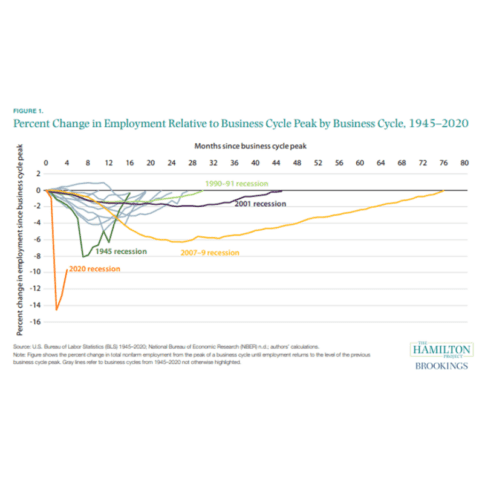Since the onset of the COVID-19 pandemic, The Hamilton Project at The Brookings Institution has produced a number of policy proposals, essays, and analyses concerning the economic policy response to the COVID-19 recession on topics ranging from food insecurity to the future of business and work to racial economic inequality.
Below you will find five figures, featured in recent Hamilton Project essays and analyses, that illustrate the economic impact of the pandemic and the need for continued policy response.
The first figure illustrates how extraordinarily fast and deep the contraction since March has been compared to past recessions. Additional support is needed to help businesses, workers, and households face the enormous challenges the pandemic and recession will create for years to come.
 To learn more, read:
To learn more, read:
- A July 2020 Hamilton Project framing paper by Wendy Edelberg and Jay Shambaugh, “How the Pandemic Is Changing the Economy.”
The figures below illustrate the large differences in non-employment rates when compared by race and education; they also highlight the disparities in household income and employment status between essential workers and non-essential workers.


To learn more, read:
- A July 2020 Hamilton Project essay by Betsey Stevenson (University of Michigan), “The Initial Impact of COVID-19 on Labor Market Outcomes Across Groups and the Potential for Permanent Scarring.”
- An August 2020 Hamilton Project analysis by Jevay Grooms (Howard University), Alberto Ortega (Indiana University), and Joaquin Alfredo-Angel Rubalcaba (UNC Chapel Hill), “The COVID-19 Public Health and Economic Crises Leave Vulnerable Populations Exposed.”
Since the onset of the COVID-19 pandemic, food insecurity has increased in the United States, particularly in households with young children. The figures below show that the alarmingly high rates of food insecurity experienced since the onset of the pandemic have been substantially higher than those measured during the height of the Great Recession in 2008. In particular, roughly a quarter of Black and Hispanic households with children were food insecure in June.

 To learn more, read:
To learn more, read:
- A July 2020 Hamilton Project economic analysis by Lauren Bauer (The Hamilton Project), Abigail Pitts (Northwestern University), Kristina Ruffini (UC Berkeley), and Diane Whitmore Schanzenbach (Northwestern University), “The Effect of Pandemic EBT on Measures of Food Hardship.”
- A July 2020 Hamilton Project analysis by Lauren Bauer, “About 14 Million Children in the US Are Not Getting Enough to Eat.”



